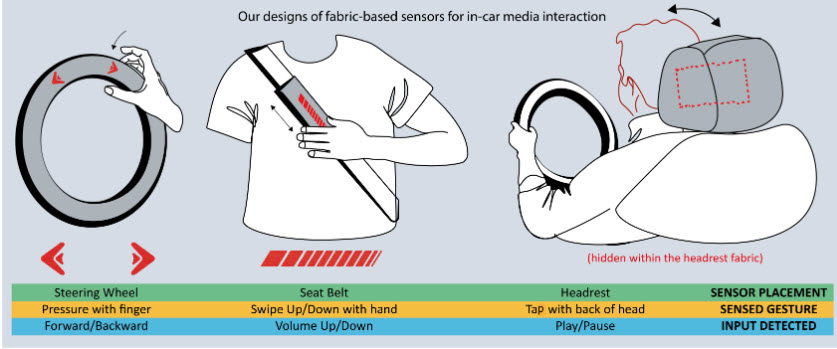This work explores e-textiles in the design space of Human-Vehicle Interaction (HVI) and compares distraction levels between e-textile and screen-based interactions during driving tasks. We developed three prototypes (in the steering wheel, headrest cover, and seat-belt pad) to support tactile interactions (tap, press, and swipe) with
car interior elements for non-driving applications (such as media control). Our designs used digital embroidery to achieve aesthetic design qualities and wireless connection. In a deployment study with 16 participants, we collected quantitative and qualitative data through video recording, field observations, and user interviews.
The study repeated all scenarios using screen-based interaction for comparison. Our findings present insights into fabric-based sensors including fewer collisions and a 302.7% decrease in eye distraction. These findings suggest new design opportunities, such DIS ’23, July 10–14, 2023, Pittsburgh, PA, USA Khorsandi, et al. as retrofitting existing vehicles, designing ideation toolkits for diverse users, devising an e-textile Fitts’ Law for reachability, and expanding vehicle interaction research within the HCI community.
This research is published here: https://doi-org.proxy.queensu.ca/10.1145/3563657.3595988

Our designed fabric-based sensors for tactile vehicle interaction using e-textiles on car leather surfaces.
The fabrication process of the interactive seat-belt pad: a) an illustration of the 5-layer slide-sensor circuit; b) a photo of the fabricated circuit; c) machine-sewing conductive thread for Layer-1 of the sensor; d) digital-embroidery of Layer-5 on the
(flat) seat-belt pad; and e) the final prototype of the (folded) seat-belt pad.


The fabrication process of the interactive steering wheel cover: a) an illustration of the circuit showing the 5-layer double-tap sensor; b) digital-embroidery of Layer-5 on the (flat) steering wheel cover; and c) the final prototype of the (rolled)
steering wheel cover.
The fabrication process of the interactive headrest cover: a) an illustration of the circuit showing b) the 5-layer multi-touch sensor; c) programming the multi-touch sensing input; and d) stacking the touchpad sensor circuit (hidden) inside the headrest cover.


Final implemented prototypes (right) versus the touchscreen interaction through the smartphone (left) when each is situated on the driving vehicle simulator.
The lab setting where the vehicle simulator is situated and the three angles where the front, side and rear cameras captured participants’ interaction with the designed sensors.


The two scenarios, i.e. city and expressway, were used for the e-textiles and screen-based interactions during the study. The left figure shows the city scenario where the participant is interacting with the steering wheel sensor,
while the right figure shows the expressway scenario where
the participant is interacting with the multitouch screen.
Acknowledgement of Funding
This project was funded by the National Sciences and Engineering Research Council of Canada (NSERC) through a Discovery Grant (2021-04135), its Discovery Supplementary Fund (2021-00310), as well as through a Queen’s University Research Initiation Grant (RIG). We acknowledge the support of Ontario Research Fund and
Canadian Foundation for Innovation for this research.